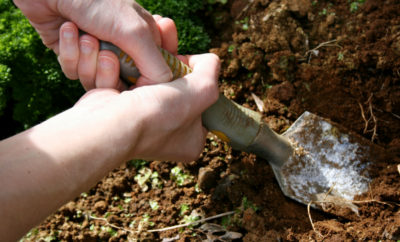Your plants, whether flowers, vegetables, grain crops, or trees, need several things to grow: nutrients, water, and sunlight. It sounds simple enough, right? Unfortunately, gardening is hardly that easy. Different plants require different amounts of water and sunlight, and because they get nutrients largely from the ground, soil requirements are very important.
When growing plants, soil is a major consideration. You need to think about the type of soil and its components, which include sand, clay, and other materials. The amount of compaction varies and changes the levels of oxygen available to the roots of your plants. The pH level of your soil is crucial to plant growth. Different soils have differing amounts of organic material, and of course there are the nutrients to think about. Before you start a big project in your garden or on your farm, do a soil analysis. This will tell you what your soil is like and what you need to do to amend it for planting.
If you plant without understanding your soil and the needs of your crops, you will probably not be as successful as you could be otherwise. When you are planting food for your family, it is worth your while to take the time and the expense of making your soil exactly what it needs to be for optimum growth and harvest.
What An Analysis Will Tell You
Depending on where you send your soil samples for analysis, you may have several choices. Most facilities will offer you a basic analysis and then several more expensive add-ons for more information about your soil.
- Basic analysis. In general, a basic analysis will test your soil for its pH, amount of organic matter, type of soil, particle size, and levels of certain nutrients. The simplest test will only give you the amounts of the three major nutrients, or the ones that plants need in the largest quantities. These are nitrogen, phosphorus, and potassium. Some basic analyses may also give you information about secondary nutrients like sulfur, magnesium, and calcium.
- Nutrient analysis. For more in-depth knowledge of the nutrient content of your soil, you may need to ask to have trace elements identified. These are nutrients such as copper, manganese, iron, zinc, aluminum, boron, and molybdenum, which are needed by plants in only very small amounts. It is possible that your soil could be depleted in a trace element, but you are more likely to have issues with the major and secondary nutrients.
- Contaminants. Another possible add-on is a test for contaminants or pollutants in your soil. When your plants take nutrients in through their roots in the soil, they also take up the bad stuff. Heavy metals like arsenic, lead, mercury, cadmium, and barium are possible soil contaminants that could be taken up by your plants and consequently get into your food. Contamination is not terribly likely in most places. If your land was an orchard in the past, you may want to test for arsenic. Fruit trees were sprayed with arsenic long ago. If you are planting near an old, painted building, lead could be a concern. If anything else in your area worries you, get your soil tested for pollutants to put your mind at ease.
- Microorganisms. Having organic matter in your soil is important because it provides your plants with the necessary nutrients for growth. Microorganisms are a part of the process. Bacteria, mostly, but also fungi, and larger organisms like worms and insects play a role in breaking down organic matter to make the nutrients accessible to your plants’ roots. Without them your soil will run out of these life-giving minerals and elements. These little critters are also responsible for moving nutrients around in the soil, eliminate certain pollutants, and aerate the soil to allow oxygen flow.
The Secrets Of Sea Minerals To Grow More “Nutritionally-Dense Food” Than You Can Possibly Eat!
How To Get An Analysis
To get a professional analysis of your soil, you need to turn to a laboratory that is equipped to find out what you want to know. There are commercial services available that will analyze your soil for a fee. A quick online search should turn up plenty of these. Another option, which may be a little less expensive, and certainly les biased when it comes to recommending fertilizers and other products, is a university. If you have a university nearby with an agricultural or horticultural department, start there. You can purchase testing kits to do yourself, but these will not give you the thorough results of a professional or academic lab. It will likely only test for pH and the three major nutrients.
Once you have found a reputable and reasonably priced service, you need to take samples. The service you are choosing may send you sample containers and instructions. If not, any clean, plastic container, such as a piece of Tupperware or a Ziploc bag, will be sufficient for taking your soil samples. Keep in mind that unless you are taking them to a nearby lab, you will need these to stay intact and sealed through the mail.
You should take samples that are several inches below the surface of the ground. This will eliminate any contamination from anything in the air or that has crossed the surface of your property, like animals. Use a clean spade to dig down several inches. The service to which you are sending your sample may ask you for soil from several different locations throughout your planting area and may provide you with plastic containers enough for all of them. If not, take soil from several random spots throughout your garden and mix them well. Take a small amount of this mixture and put it in your sampling container. This way, you are getting an analysis that represents the entirety of your soil. If you are planning to plant in several different plots, send in at least one mixed sample per plot.
Recommendations
Another great reason to get a professional soil analysis is that you should come away with more than just the raw data. You should also get detailed recommendations for how to amend your soil for growing healthy and fruitful plants. Before you send in a sample to your testing facility, tell them what type of plants you are putting in the ground. If you are not fully certain of the exact types, indicate whether it is going to be grazing for your livestock, an area for fruit trees, or a vegetable garden. The service may be able to suggest certain tests that may be useful.
Telling the lab what you will be planting also allows them to come up with a good recommendation plan for you. Once you have the analysis it will do you little good if you have no idea what it means. The service should provide you with an explanation of the results and should detail the concerns with your soil. They should also tell you exactly what you need to do to amend your soil for your planned plantings. This could include a recommended fertilizer and schedule for using it, whether you need compost, or what you can do to raise or lower the pH to a more desirable level.
 Off The Grid News Better Ideas For Off The Grid Living
Off The Grid News Better Ideas For Off The Grid Living





